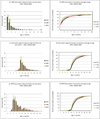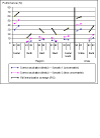Monitoring the performance of the Expanded Program on Immunization: the case of Burkina Faso
- PMID: 19828056
- PMCID: PMC3226231
- DOI: 10.1186/1472-698X-9-S1-S12
Monitoring the performance of the Expanded Program on Immunization: the case of Burkina Faso
Abstract
Background: The greatest challenge facing expanded programs on immunization in general, and in Burkina Faso in particular, lies in their capacity to achieve and sustain levels of immunization coverage that will ensure effective protection of children. This article aims to demonstrate that full immunization coverage of children, which is the primary indicator for monitoring national immunization programs, is sufficient neither to evaluate their performance adequately, nor to help identify the broad strategies that must be implemented to improve their performance. Other dimensions of performance, notably adherence to the vaccination schedule and the efficacy of the approaches used to reach all the children (targeting) must also be considered.
Methods: The study was carried out using data from surveys carried out in Burkina Faso: the 1993, 1998 and 2003 Demographic and Health Surveys and the 2003 national Survey of Immunization Coverage. Essentially, we described levels of immunization coverage and their trends according to the indicators considered. Performance differences are illustrated by amplitudes and maximum/minimum ratios.
Results: The health regions' performances vary according to whether they are evaluated on the basis of full immunization coverage or vaccination status of children who have not completed their vaccinations. The health regions encompass a variety of realities, and efforts of substantially different intensity would be required to reach all the target populations.
Conclusion: Decision-making can be improved by integrating a tripartite view of performance that includes full immunization coverage, adherence to the vaccination schedule (timely coverage), and the status of children who are not fully vaccinated. With such an approach, interventions can be better targeted. It provides information on the quality and timeliness of vaccination and identifies the efforts required to meet the objectives of full immunization coverage. ABSTRACT IN FRENCH: See the full article online for a translation of this abstract in French.
Figures
Similar articles
-
Evaluation of immunization coverage within the Expanded Program on Immunization in Kita Circle, Mali: a cross-sectional survey.BMC Int Health Hum Rights. 2009 Oct 14;9 Suppl 1(Suppl 1):S13. doi: 10.1186/1472-698X-9-S1-S13. BMC Int Health Hum Rights. 2009. PMID: 19828057 Free PMC article.
-
Assessment of factors associated with complete immunization coverage in children aged 12-23 months: a cross-sectional study in Nouna district, Burkina Faso.BMC Int Health Hum Rights. 2009 Oct 14;9 Suppl 1(Suppl 1):S10. doi: 10.1186/1472-698X-9-S1-S10. BMC Int Health Hum Rights. 2009. PMID: 19828054 Free PMC article.
-
Quality and reliability of vaccination documentation in the routine childhood immunization program in Burkina Faso: Results from a cross-sectional survey.Vaccine. 2020 Mar 17;38(13):2808-2815. doi: 10.1016/j.vaccine.2020.02.023. Epub 2020 Feb 20. Vaccine. 2020. PMID: 32089461
-
Immunization coverage in young children: a study nested into a health and demographic surveillance system in Burkina Faso.J Trop Pediatr. 2013 Jun;59(3):187-94. doi: 10.1093/tropej/fms075. Epub 2013 Jan 29. J Trop Pediatr. 2013. PMID: 23363884
-
Effectively introducing a new meningococcal A conjugate vaccine in Africa: the Burkina Faso experience.Vaccine. 2012 May 30;30 Suppl 2:B40-5. doi: 10.1016/j.vaccine.2011.12.073. Vaccine. 2012. PMID: 22607898 Review.
Cited by
-
Overview of global, regional, and national routine vaccination coverage trends and growth patterns from 1980 to 2009: implications for vaccine-preventable disease eradication and elimination initiatives.J Infect Dis. 2014 Nov 1;210 Suppl 1(0 1):S514-22. doi: 10.1093/infdis/jiu108. J Infect Dis. 2014. PMID: 25316875 Free PMC article.
-
Timeliness of routine childhood vaccination in 103 low-and middle-income countries, 1978-2021: A scoping review to map measurement and methodological gaps.PLOS Glob Public Health. 2022 Jul 14;2(7):e0000325. doi: 10.1371/journal.pgph.0000325. eCollection 2022. PLOS Glob Public Health. 2022. PMID: 36962319 Free PMC article.
-
Vaccination timeliness and delay in low- and middle-income countries: a systematic review of the literature, 2007-2017.Hum Vaccin Immunother. 2019;15(12):2790-2805. doi: 10.1080/21645515.2019.1616503. Epub 2019 Jun 12. Hum Vaccin Immunother. 2019. PMID: 31070992 Free PMC article.
-
Heterogeneity in the validity of administrative-based estimates of immunization coverage across health districts in Burkina Faso: implications for measurement, monitoring and planning.Health Policy Plan. 2010 Sep;25(5):393-405. doi: 10.1093/heapol/czq007. Epub 2010 Feb 25. Health Policy Plan. 2010. PMID: 20185529 Free PMC article.
-
Monitoring Results in Routine Immunization: Development of Routine Immunization Dashboard in Selected African Countries in the Context of the Polio Eradication Endgame Strategic Plan.J Infect Dis. 2017 Jul 1;216(suppl_1):S226-S236. doi: 10.1093/infdis/jiw635. J Infect Dis. 2017. PMID: 28838180 Free PMC article.
References
-
- Guérin N. Couverture vaccinale dans les pays pauvres [Vaccination coverage in poor countries] Santé publique et pays pauvres. 2000. pp. 56–57.
-
- Bicaba A, Haddad S, Traore A, Toe F, Zida B, Ouedraogo B, Fournier P, Zunzunegui MV, Feletto M. Profil des inegalités de couverture vaccinale au Burkina Faso [Profile of inequalities in vaccination coverage in Burkina Faso]; Research Report. 2005.
-
- UNICEF. Multiple Indicator Cluster Survey (MICS). Monitoring the situation of children and women. Division of policy and planning, Manual. 2005.
-
- Espeut D. Knowledge, Practices and Coverage Survey 2000+ Field Guide. The child survival support group. The Child Survival Technical Support Project; 2001;Chapter 5:90–91.
LinkOut - more resources
Full Text Sources



